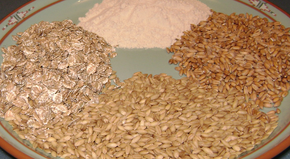
Back Gluten Afrikaans غلوتين Arabic Gluten AST Qlüten Azerbaijani گلوتن AZB Глютэн Byelorussian Глютэн BE-X-OLD Глутен Bulgarian ग्लूटेन Bihari Gluten Breton

Gluten is a structural protein naturally found in certain cereal grains.[1] The term gluten usually refers to a wheat grain's prolamins, specifically glutelin proteins, that naturally occur in many cereal grains, and which can trigger celiac disease in some people. The types of grains that contain gluten include all species of wheat (common wheat, durum, spelt, khorasan, emmer and einkorn), and barley, rye, and some cultivars of oat; moreover, cross hybrids of any of these cereal grains also contain gluten, e.g. triticale.[2][3] Gluten makes up 75–85% of the total protein in bread wheat.[4][5]
Glutens, especially Triticeae glutens, have unique viscoelastic and adhesive properties, which give dough its elasticity, helping it rise and keep its shape and often leaving the final product with a chewy texture.[4][6][7] These properties, and its relatively low cost, make gluten valuable to both food and non-food industries.[7]
Wheat gluten is composed of mainly two types of proteins: the glutenins[8] and the gliadins,[9] which in turn can be divided into high molecular and low molecular glutenins and α/β, γ and Ω gliadins. Its homologous seed storage proteins, in barley, are referred to as hordeins, in rye, secalins, and in oats, avenins.[10] These protein classes are collectively referred to as "gluten".[3] The storage proteins in other grains, such as maize (zeins) and rice (rice protein), are sometimes called gluten, but they do not cause harmful effects in people with celiac disease.[2]

Gluten can trigger adverse, inflammatory, immunological, and autoimmune reactions in some people. The spectrum of gluten related disorders includes celiac disease in 1–2% of the general population, non-celiac gluten sensitivity in 0.5–13% of the general population, as well as dermatitis herpetiformis, gluten ataxia and other neurological disorders.[11][12][13][14] These disorders are treated by a gluten-free diet.[14]
- ^ Hervé This, « Who discovered the gluten and who discovered its production by lixiviation? », Notes Académiques de l'Académie d'Agriculture de France/Academic Notes from the French Academy of Agriculture, vol. 3, no 3, 2002, p. 1–11 (PMID 11911770, PMCID 1692935, DOI 10.1098/rstb.2001.1024).
- ^ a b Food and Drug Administration (January 2007). "Food Labeling; Gluten-Free Labeling of Foods" (PDF). Food and Drug Administration. Archived from the original (PDF) on 2007-01-26.
- ^ a b Biesiekierski JR (2017). "What is gluten?". J Gastroenterol Hepatol (Review). 32 (Suppl 1): 78–81. doi:10.1111/jgh.13703. PMID 28244676.
Similar proteins to the gliadin found in wheat exist as secalin in rye, hordein in barley, and avenins in oats, and are collectively referred to as 'gluten'. The gluten found in all of these grains has been identified as the component capable of triggering the immune-mediated disorder, celiac disease.
- ^ a b Cite error: The named reference
shewry1was invoked but never defined (see the help page). - ^ "Gluten's role in bread baking performance". Canadian Grain Commission. 29 March 2016.
- ^ Lamacchia C, Camarca A, Picascia S, Di Luccia A, Gianfrani C (Jan 29, 2014). "Cereal-based gluten-free food: how to reconcile nutritional and technological properties of wheat proteins with safety for celiac disease patients". Nutrients (Review). 6 (2): 575–90. doi:10.3390/nu6020575. PMC 3942718. PMID 24481131.
the distinctive feature that makes wheat unique is, precisely, the visco-elasticity of gluten. When the grain is milled and mixed with water, storage proteins form a dough, capable of retaining gas bubbles. These properties make wheat suitable for the preparation of a great diversity of food products
- ^ a b Day L, Augustin MA, Batey IL, Wrigley, CW (February 2006). "Wheat-gluten uses and industry needs". Trends in Food Science & Technology (Review). 17 (2): 82–90. doi:10.1016/j.tifs.2005.10.003.
Given the unique properties of wheat gluten, it is not surprising that it has been the subject of intense attention by the food industry. (...) Gluten does have economic benefits over and above the more expensive milk- or soy-protein products (Table 1), and its functional properties, which other products cannot duplicate, give it a unique place among the various protein products. (...) Unlike whey and soy proteins, gluten or wheat proteins are not high in biological value and have not been widely researched for nutritional advantages.
- ^ Payne, P. I. (2012-12-06). "Endosperm Proteins". In Blonstein, A. D.; King, P. J. (eds.). A Genetic Approach to Plant Biochemistry. Springer Science & Business Media. p. 210. ISBN 9783709169896.
- ^ Zhao, Hefei (February 2020). "Comparison of wheat, soybean, rice, and pea protein properties for effective applications in food products". Journal of Food Biochemistry. (44)4 (4): e13157. doi:10.1111/jfbc.13157. PMID 32020651. S2CID 211034183.
- ^ Rosentrater, Kurt A.; Evers, A.D. (2018). "Chemical components and nutrition". Kent's Technology of Cereals. pp. 267–368. doi:10.1016/B978-0-08-100529-3.00004-9. ISBN 978-0-08-100529-3.
- ^ Cite error: The named reference
LundinWijmenga2015was invoked but never defined (see the help page). - ^ Cite error: The named reference
MolinaInfanteSantolariawas invoked but never defined (see the help page). - ^ Cite error: The named reference
LudvigssonLeffler2013was invoked but never defined (see the help page). - ^ a b Cite error: The named reference
ZisHadjivassiliou2019was invoked but never defined (see the help page).
© MMXXIII Rich X Search. We shall prevail. All rights reserved. Rich X Search